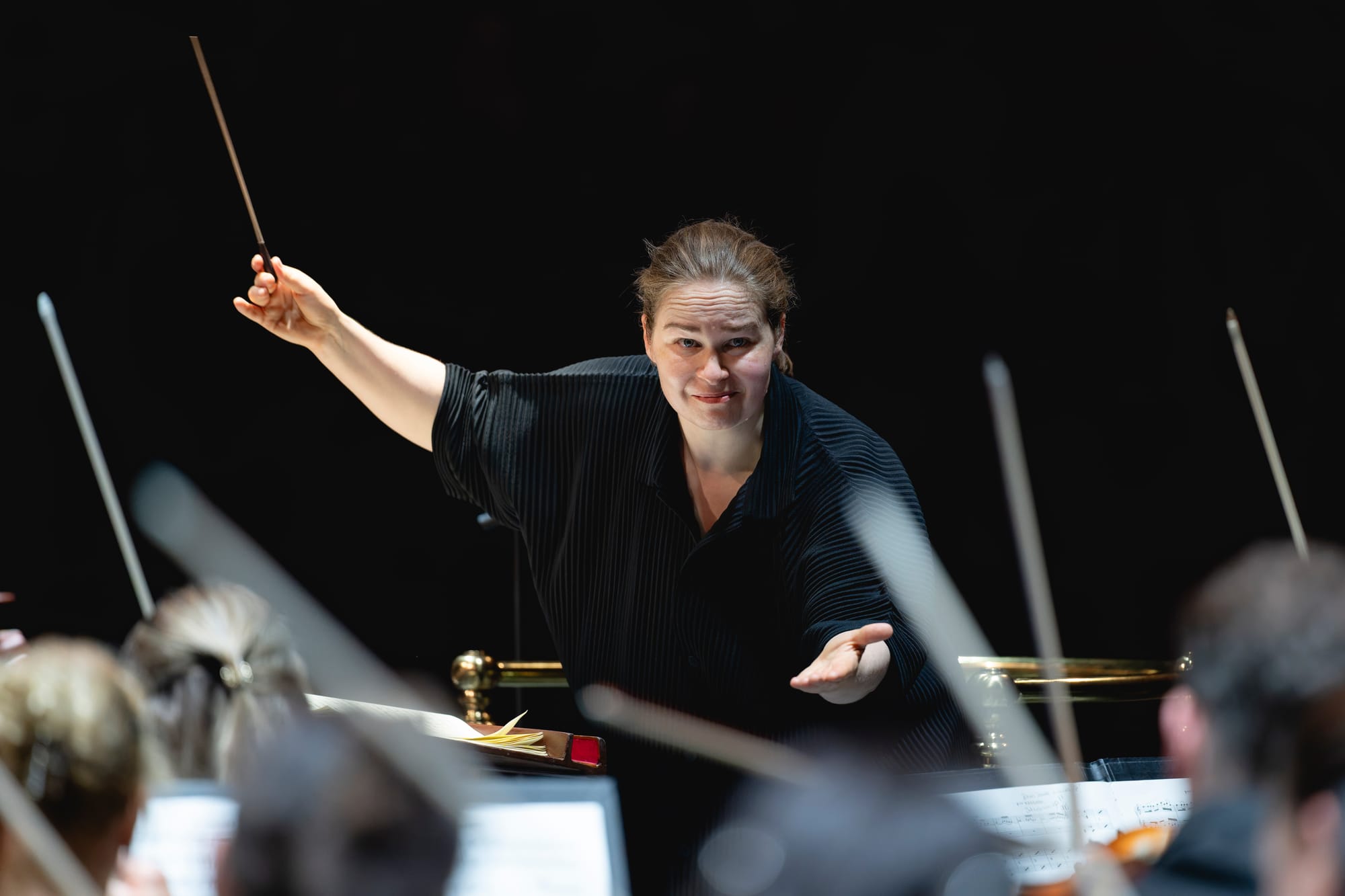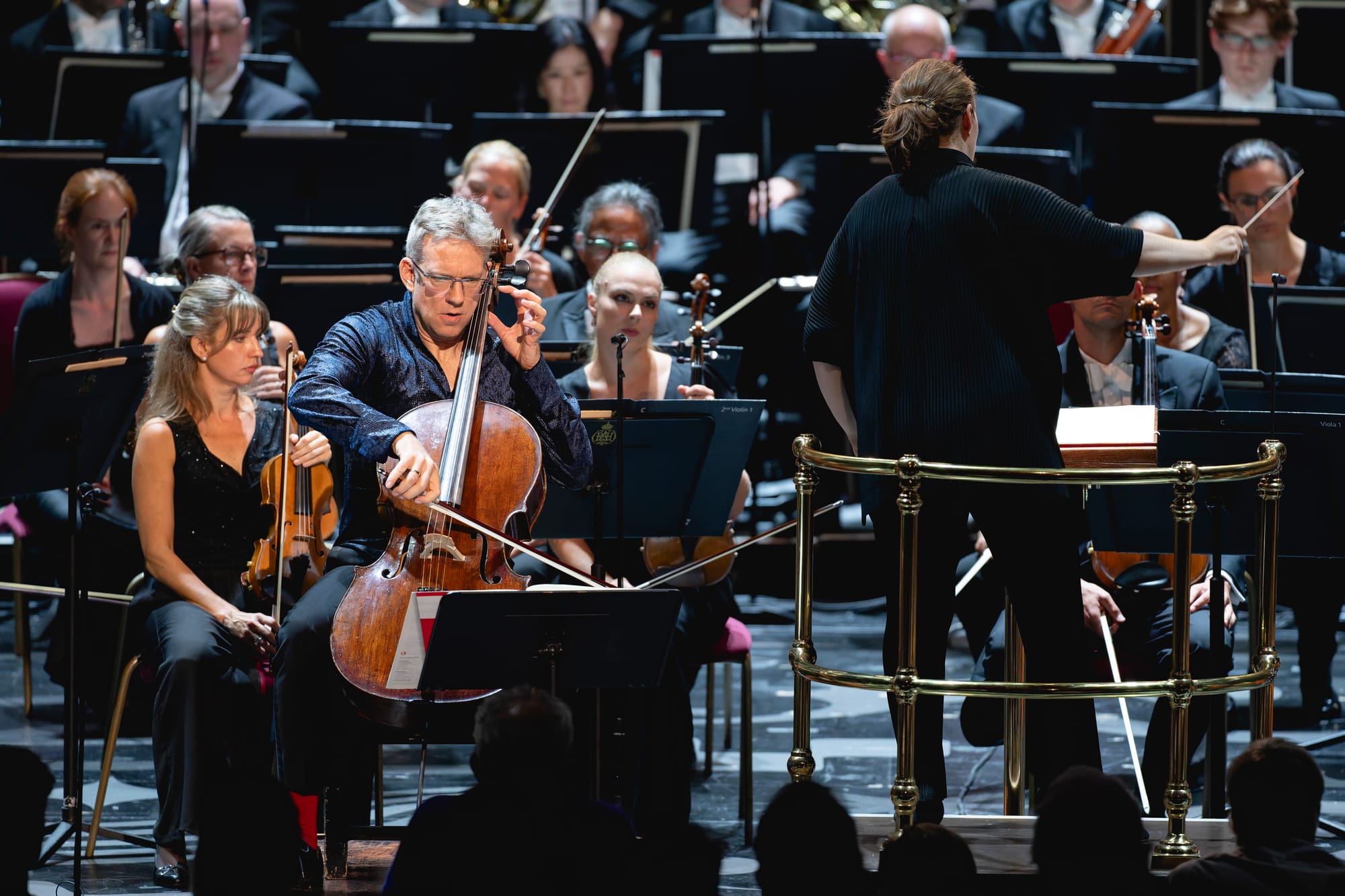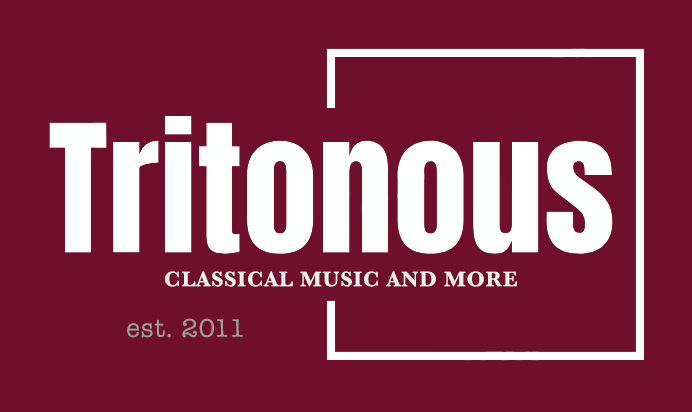
PROMS 2025: Varèse, Thovaldsdottir, Ravel, Stravinsky Johannes Moser (cello); BBC Symphony Orchestra / Eva Ollikainen (conductor). Royal lbert Hall, 13.08.2025
Varèse Intégales (1924/25)
Thorvaldsdottir Before We Fall (2024, UK premiere)
Ravel Boléro (1928)
Stravinsky Le sacre du primtemps (1911-13)
Wha a tempting array of music: for 20th-Century nerds and those who enjoy music with the ink still wet, perhaps. And yet, this looked to me like a sold-out Royal Albert Hall; someone is doing something right in publicity.
The music of Edgard Varèse (1983-1965) does not get out much these days. A shame, as pieces such as Octandre, Ionisation and, indeed Intégrales, make an indelible mark on those that dare to hear them. Varèse’s uncompromising demeanour does nto preclude reference points, most obviously Stravinsky. The music eschews strings: it does however include woodwind (including two piccolos), brass (including a contrabass trombone) and a raft of percussion (including sleigh bells, lion’s roar and chains). Eva Ollikainen, current Principal Conductor of the Iceland Symphony Orchestra, has a super-clean beat, which resulted in razor-sharp ensemble. Brass in particular was impressive, particularly when they act as one.
Anna Thorvaldsdottir’s cello concerto, Before We Fall, explores the idea of being on the edge, and the resultant tension. Icelandic herself, she enjoys a close relationship with the Iceland Symphony Orchestra (elsewhere, in 2015, she became the inaugural Kavis Young Composer at the New York Philharmonic). It has been suggested (by Nordic expert Andrew Mellor) that Thorvaldsdottir’s music echoes the vast canvases of fellow Icelander Jon Leifs. Amazingly, her first major work was only composed in 2010 (Dreaming).

Thorvaldsdottir’s scoring can be individual, too: the score asks for dried eucalyptus leaves on a drum, for example. One thing is for sure: her ear is hyper-keen. There is both radiance and darkness to Thorvaldsdottir’s score (perhaps the idea of the ’black sun’ subsists here; think of an eclipse). The soloist was the extraordinary Johannes Moser, a nomadic wanderer in a heady, forbidding orchestral landscape. Thorvaldsdottir is capable of creating a seething mass of strings (as early on) but also real warmth, then (at the opening of the concerto’s second section) a sense of Sibelian stasis. Moser’s lyricism was infinitely touching; vibrating, oscillating percussion seemed to seek to destablise his musings. Almost atemporal, ghostly, Thorvaldsdottir’s music can sometimes imply a sort of distended folk melody; always destabilised in some way by the orchestral (chthonic double-basses have real part to play here). Nothing is left to chance, everything is carefully sculpted, and the performance seemed to underline this – the handing over from cello to orchestra of a line, for example. If Birtwistle wrote about an Earth that dances, Thovaldsdottir seems to seek to express the scale and depth of the planet itself. Before we fall is, as the title suggests, music on the edge, and a feeling of expectancy, perhaps somewhat fearful, pervades. Perhaps the opening of the cello cadenza makes this clear: as the soloist explores, double-basses ground the music, as if ‘pulling’ the soloist towards them via gravity.
This is an extraordinary piece, one of the Proms’ most significant (local) premieres. Every piece I hear by Thorvaldsdottir only increases my respect for her; Before we fall is stunning. Moser’s performance was a tour de force backed by supreme confidence by the BBC SO under Ollikainen.
So why, oh, why, not place the interval there? That is plenty for a first half: 12 minutes for the Varèse, 26 for Thorvaldsdottir. Including the stage management (considerable), did we really need Ravel’s Boléro and then a piece that lasts around 33 minutes alone in the second half? Surely put it afterwards? Anyway, it was a brilliant performance of Boléro, colourful, masterly paced, with the pervading rhythm maintained superbly throughout. And that rhythm was a vital element to this account: it remained constant but, in a nod towards Ravel’s proximity to jazz and blues, soloists were allowed (presumably encouraged) to ‘ride’ the beat. It worked, brilliantly, trombone glisses swooning, sudden wind band coming into focus to bring back the discipline. And through all of this, Ollikainen never lost sight of the bigger picture; this was a calibrated crescendo of colour culminating in outrageous trombones and a final graphic collapse in hat final gesture. No wonder the audience went nuts: ti is not just that everyone knows this one, but that Ravel’s masterpiece (in its own way just as modern as Varèse) made its full mark.
And so to Le sacre. The leisurely bassoon solo that opened seemed to refer back to the timelessness of Thorvldsdottir rather than the wind solos of Intégrales. Ollikainen offered a fascinating, highly individual view that seemed to combine an X-ray approach to the score (only Boulez in my experience as equalled this performance) with a sense of dance. The elemental, the primal, was lessened here, as texture and line, with that ever-present sense of dance, took precedence. Nowhere was this more obvious than in Ollikainen’s carefully crafted crescendos. The bassoon solo (Jonathan Davies) was masterly; no less so the horn playing of Nicholas Korth. Ollikainen brought out the ritualistic aspect well, both in the ‘Sacrificial Dance’ itself and in some of the quieter moments (muted trumpets). Perhaps the most impressive aspect was that this Rite was never cacophonous. Loud, yes, but the components of Stravinsky’s scoring, and in particular his layering, were ever-audible. I have heard more exciting accounts, but rarely one so interesting, so devoted to Stravinsky’s score, so aware that his is a ballet, not a symphonic work. I do wonder if that sense of the dance is part of Ollikainen, simply because she finds a sense of dance-like ‘lift’ to rhythms in her fine recording of Kalevi Aho’s Piano Concerto No. 1 (with Sonja Fräki, piano, and the Turko Philharmonic, on BIS), My own experience of Ollikainen previously only came from one source: a recording of Molly Kien’s Pyramid on DB Records (my review appeared in the American journal Fanfare). Ollikainen also presides over a coupling of Kabalevsky and Schumann Cello Concertos with Theodor Lyngstad on OUR Recordings (Copenhagen Philharmonic). Her repertoire is nothing if not wide, then, her conducing pedigree of the best (Leif Segerstam and Jorma Panula at Helsinki’s Sibelius Academy). She has recorded Thorvaldsdottir’s ARCHORA and AION with the Iceland SO. very much want to experience a concert led by her again, and soon.
A most memorable concert.










